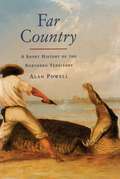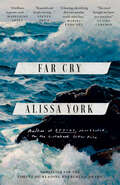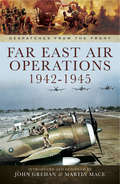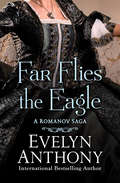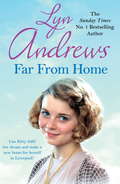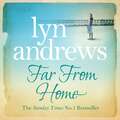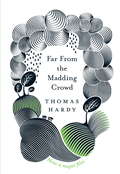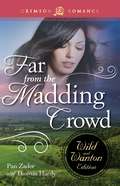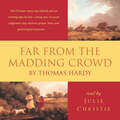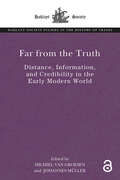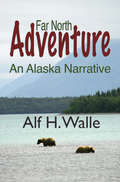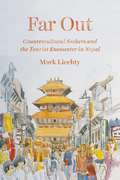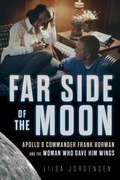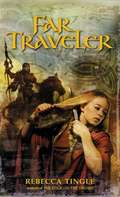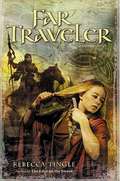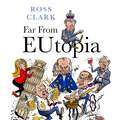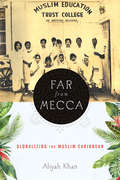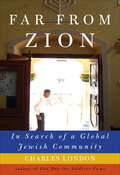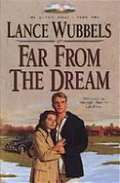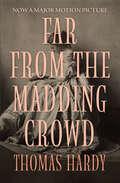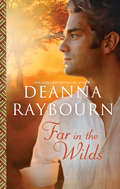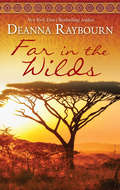- Table View
- List View
Far Country: A Short History of the Northern Territory
by Alan PowellThis is a full and revealing account of the perilous and adventurous course of the Northern Territory; a comprehensive account of its history which debunks the myths and makes human both the high and low points. During the second half of this century writers, journalists and the tourist trade have promoted the image of the Territory as Australia's last frontier. To many Australians who live south of the Tropic of Capricorn the far north is still outside the real Australia. Until recently it was an area largely neglected by Australian historians who concentrated their work on the south-east corner of the continent. Alan Powell's work was one of the first to help redress that balance. The Northern Territory is a wondrous place of bizarre natural history and eccentric personalities; of great unrest and great triumph. Far Country presents the place and its story with skill and simplicity.
Far Cry
by Alissa YorkIn a novel as compelling as the forbidden love at its heart, Alissa York, one of Canada's most distinctive writers, evokes an era of unspoken desires in which pain and longing are braided together along treacherous lines.It's 1922 at Far Cry Cannery, a quarter-mile of boardwalk and wooden buildings strung along the rocks of Rivers Inlet on the northwest coast of British Columbia. The time has come for Anders Viken, storekeeper and honorary uncle to the recently orphaned Kit, to give an account of his secret self—from his first home in Norway, another land of islands and fjords, to his escape from his family's loving grip, to his wide-open years of rough living and impossible love.As the sockeye flood up the inlet, Anders sets his secrets down for 18-year-old Kit, the only member of his chosen family he has left after her mother, Bobbie, scandalized Far Cry by running off with the camp's handsome Chinese cook, and her father, Frank, was found drowned alongside his own boat. While Anders does his reckoning, Kit fends off the attentions of the cannery manager and tries to earn her keep. Oars in hand, she glides her skiff out over the great returning school and casts her net. This, at least, makes sense to her, as opposed to the convoluted workings of love.
Far East Air Operations, 1942–1945 (Despatches from the Front)
by Martin Mace John GrehanDespatches in this volume include Air Operations in Burma and Bay of Bengal 1 January to 22 May 1942 by General Wavell, the despatch on air operations in South-East Asia November 1943 to May 1944, by Air Chief Marshal Sir R.E.C. Peirse, the despatch on air operations in South-East Asia from June 1944 to May 1945, by Air Chief Marshal Sir Keith Park, and the despatch on air operations in South East Asia between May 1945 and September 1945, by Air Chief Marshal Sir Keith Park.This unique collection of original documents will prove to be an invaluable resource for historians, students and all those interested in what was one of the most significant periods in British military history.
Far Flies the Eagle: Rebel Princess, Curse Not The King, And Far Flies The Eagle (The Romanov Trilogy #3)
by Evelyn AnthonyImperial Russia's Czar Alexander I battles Napoleon for control of Europe After declaring himself Emperor of France following a sweeping victory in Europe, General Napoleon Bonaparte, the son of a poor Corsican lawyer, is ready for his next conquest. He has no doubt that he can defeat Austria, and is confident that Russia will soon follow. After all, he triumphed in revolution and recast an empire. What has he to fear from the twenty-nine-year-old czar of a barbaric country? The grandson of Catherine the Great, Alexander I is tall, irresistibly handsome, and known for his liberal leanings and winning ways with women who are not his wife. He ascended to the throne by murdering his father and is now determined to vanquish the French emperor. Napoleon will soon learn that he has a formidable adversary in Alexander. Sweeping from St. Petersburg to Paris, from the Kremlin to the battlefield, and filled with historic authenticity, Far Flies the Eagle offers a fascinating glimpse into the Romanov family, including the controversy surrounding Alexander's relationship with his beautiful, power-hungry sister, the Grand Duchess Catherine, whom Napoleon considers marrying if he can rid himself of his years-older wife Josephine. Far Flies the Eagle is the 3rd book in the Romanov Trilogy, but you may enjoy reading the series in any order.
Far From Home (The Roman Pony Adventures #3)
by K. M. PeytonWhen Minna's true love Theo sets off north to battle, commanding an army that includes her brother, her friends and her beloved horse, Silva, Minna cannot bear to see them all leave her. Regardless of the dangers she will be facing, she joins the baggage train and becomes a Roman spy. Army life is hard and brutal, yet her growing closeness with Theo makes it bearable. Could he finally admit his love for her? But when Theo is wounded in battle and Silva is stolen by the enemy, Minna must throw off all her romantic dreams and set off alone on a life-or-death mission to save her horse.
Far From Home: A young woman finds hope and tragedy in 1920s Liverpool
by Lyn AndrewsWhen blacksmith's daughter Kitty Doyle catches the eye of her grocer employer it seems her troubles are over - but there are still dramas to come... In Far From Home, Lyn Andrews travels between both Ireland and Liverpool in this engrossing saga of new beginnings, new tragedies and new loves. Perfect for fans of Anne Baker, Annie Murray and Dilly Court.As daughter of the blacksmith in her tiny Irish village, fifteen-year-old Kitty Doyle knows little of the ways of the world, but she has to grow up fast when her widowed father re-marries and she has no choice but to leave the family home.Luckily there's work to be found over the water in 1920s Liverpool and soon Kitty has a job in a grocer's, where she also catches the eye of the owner.With Kitty's input the business is soon thriving - but tragedy lies ahead, and she must endure many trials and tribulations before she can find true happiness... What readers are saying about Far From Home: 'A very good read, enjoyed every page. A typical Lyn Andrews book, riveting to the very end. Thoroughly recommend this book''Another enthralling read from Lyn Andrews, I couldn't put it down from start to finish. You will not be disappointed'
Far From Home: A young woman finds hope and tragedy in 1920s Liverpool
by Lyn AndrewsAs daughter of the blacksmith in her tiny Irish village, fifteen-year-old Kitty Doyle knows little of the ways of the world, but she has to grow up fast when her widowed father re-marries and she has no choice but to leave the family home. Luckily there's work to be found over the water in 1920s Liverpool and soon Kitty has a job in a grocer's, where she also catches the eye of the owner. With Kitty's input the business is soon thriving - but tragedy lies ahead, and she must endure many trials and tribulations before she can find true happiness...(P)2012 Headline Digital
Far From The Madding Crowd (film)
by Thomas Hardy'. . . the past was yesterday; the future, tomorrow; never, the next day'It's the 1870s and Bathsheba Everdene is a woman ahead of her time. Within the confines of rural English society, her independence and impulsive nature quickly land her at the heart of a web of love and lies. Three very different men hope to claim her. But Bathsheba is fickle. And as she forges her own path through the politics of love and marriage, disaster follows in her wake.FAR FROM THE MADDING CROWD is a tale of loyalty, obsession and tragedy from a storytelling master. Soon to be a film starring Carey Mulligan, Michael Sheen and Tom Sturridge.
Far From The Madding Crowd: The Wild And Wanton Edition
by Pan ZadorAn earthy tale of country loving in 1870s England; Bathsheba Everdene is that unusual combination - a beautiful young woman who is also mistress of her own farm. Proposals of marriage are not long in coming, but with her lack of experience in judging men, how can she possibly choose between the solid young shepherd Gabriel Oak, the dignified squire Farmer Boldwood, or the dashing sergeant of Hussars, Francis Troy?Now with added explicit scenes of seduction, shameless pursuit, and solitary frustration - as we follow Bathsheba’s initiation into physical love.Sensuality Level: Sensual
Far From The Madding Crowd: The Wild And Wanton Edition
by Thomas Hardy Pan ZadorAn earthy tale of country loving in 1870s England; Bathsheba Everdene is that unusual combination - a beautiful young woman who is also mistress of her own farm. Proposals of marriage are not long in coming, but with her lack of experience in judging men, how can she possibly choose between the solid young shepherd Gabriel Oak, the dignified squire Farmer Boldwood, or the dashing sergeant of Hussars, Francis Troy?Now with added explicit scenes of seduction, shameless pursuit, and solitary frustration - as we follow Bathsheba’s initiation into physical love.Sensuality Level: Sensual
Far From the Madding Crowd
by Thomas HardyFAR FROM THE MADDING CROWD is perhaps the best-known of Hardy's works. The story centres around the beautiful and wilful Bathsheba Everdene, mistress of Weatherbury Upper Farm, and the three men who love her. Hardy combines outstanding description of West Country rural life with a deep sense of romantic passion.(P)2003 Hodder & Stoughton Audiobooks
Far From the Truth: Distance, Information, and Credibility in the Early Modern World
by Johannes Müller Michiel Van GroesenInformation and knowledge were essential tools of early modern Europe’s global ambitions. This volume addresses a key concern that emerged as the competition for geopolitical influence increased: how could information from afar be trusted when there was no obvious strategy for verification? How did notions of doubt develop in relation to intercultural encounters? Who were those in the position to use misinformation in their favour, and how did this affect trust? How, in other words, did distance affect credibility, and which intellectual and epistemological strategies did early modern Europe devise to cope with this problem? The movement of information, and its transformations in the process of gathering, ordering, and disseminating, makes it necessary to employ both a global and a local perspective in order to understand its significance. The rise of print, leading to various new forms of mediation, played a crucial role everywhere, inspiring theories of modernization in which media served as agents of new connections and, eventually, of globalization. Paradoxically, during the entire period between 1500 and 1800, the demise of distance through various strategies of verification coincided with constructions of otherness that emphasized the cultural and geographical difference between Europe and the worlds it encountered. Ten leading scholars of the early modern world address the relationship between distance, information, and credibility from a variety of perspectives. This volume will be an essential companion to those interested in the history of knowledge and early modern encounters, as well as specialists in the history of empire and print culture.
Far North Adventure: An Alaska Narative
by Alf WalleUnfortunately, most visitors to Alaska have but a few days to explore. As a result, much goes unseen and unknown. Gain the visions you missed by hitchhiking along with my recollections of a ten year foray into the Last Frontier. Drive the Alaska Highway, taking side trips to Dawson City and Valdez. Stalk moose and catch salmon with Athabascan Indians who still follow a subsistence way of life. Observe an Inupiaq whale hunt on the Arctic Ocean. Visit the rural neighborhood where dog sledding heroes, such as Lance Mackey and Ken Anderson, live and practice their sport. Fly by bush plane into remote camps and live with exploration teams. See how frontier boom towns, like Fairbanks and Nome, as well as Native villages, are evolving. These and many more exciting adventures await. You can't see Alaska in a few days. But you can experience it through my eyes and Far North Adventure.
Far Out: Countercultural Seekers and the Tourist Encounter in Nepal
by Mark LiechtyWesterners have long imagined the Himalayas as the world’s last untouched place and a repository of redemptive power and wisdom. Beatniks, hippie seekers, spiritual tourists, mountain climbers—diverse groups of people have traveled there over the years, searching for their own personal Shangri-La. In Far Out, Mark Liechty traces the Western fantasies that captured the imagination of tourists in the decades after World War II, asking how the idea of Nepal shaped the everyday cross-cultural interactions that it made possible. Emerging from centuries of political isolation but eager to engage the world, Nepalis struggled to make sense of the hordes of exotic, enthusiastic foreigners. They quickly embraced the phenomenon, however, and harnessed it to their own ends by building tourists’ fantasies into their national image and crafting Nepal as a premier tourist destination. Liechty describes three distinct phases: the postwar era, when the country provided a Raj-like throwback experience for rich Americans; Nepal’s emergence as an exotic outpost of hippie counterculture in the 1960s; and its rebranding into a hip adventure destination, which began in the 1970s and continues today. He shows how Western projections of Nepal as an isolated place inspired creative enterprises and, paradoxically, allowed locals to participate in the global economy. Based on twenty-five years of research, Far Out blends ethnographic analysis, a lifelong passion for Nepal, and a touch of humor to produce the first comprehensive history of what tourists looked for—and found—on the road to Kathmandu.
Far Side of the Moon: Apollo 8 Commander Frank Borman and the Woman Who Gave Him Wings
by Liisa JorgensenThe decades-long love story of a NASA commander and the leader of the Astronaut Wives ClubFar Side of the Moon is the untold, fully authorized story of the lives of Frank and Susan Borman. One was a famous astronaut—an instrumental part of the Apollo space program—but the other was just as much a warrior. This real-life love story is far from a fairy tale. Life as a military wife was beyond demanding, but Susan always rose to the occasion. When Frank joined NASA and was selected to command the first mission to orbit the moon, that meant putting on a brave face for the world as her husband risked his life for the space race. The pressure and anxiety were overwhelming, and eventually Susan's well-hidden depression and alcoholism finally came to light. Frank had to come to terms with how his "mission above all else" mentality contributed to his wife's suffering. As Susan healed, she was able to begin helping others who suffered in silence from mental illness and addiction.Discover how Frank and Susan's love and commitment to each other is still overcoming life's challenges, even beyond their years as an Apollo commander and the founder of the Astronaut Wives Club.
Far Traveler
by Rebecca TingleWhen King Edward gives his niece AElfwyn two choices--marry one of his allies or become a nun--Wyn flees. Disguising herself as a boy, she adopts a new identity as a traveling storyteller and soon becomes embroiled in a plot against her own uncle. Sequel to The Edge on the Sword.
Far Traveler
by Rebecca TingleWhen King Edward gives his niece ®lfwyn two choices-marry one of his allies or become a nun-Wyn is at a loss to decide. Her strong, warrior mother has just died, so it's impossible to know what she would have wanted. Wyn takes the first risk of her life and flees. Disguising herself as a boy, she adopts a new identity as a traveling storyteller called Widsith (far traveler) and reinvents herself, drawing upon the books she has loved all her life. Soon she finds her fate inextricably tied with the dark-eyed King Wilfrid, who knows her only as Widsith, and wants her help in a plot against her own uncle.
Far from Eutopia: How Europe is failing – and Britain could do better
by Ross ClarkIn 2020, after three and a half years of bitter negotiations, Britain left the European Union. For some it was a day of freedom, for others a tragedy which would leave Britain isolated and poorer. Vote Brexit, the Remain campaign warned us, and it would be an act of self-harm. The economy would collapse, sending prices and unemployment soaring. Meanwhile, in contrast to xenophobic, inward-looking Britain, the EU would soar ahead without us.But is that really what has happened? Ross Clark reveals just how badly the EU is doing - and how in many ways Britain is doing better. Since Brexit, for example, the UK economy has grown faster than Germany's. In spite of inflation which followed the pandemic and the invasion of Ukraine, Britain has the lowest food prices in Europe. The air is cleaner than in many countries. Despite recent events surveys suggest there is less racism and xenophobia in Britain than in almost any other European country.For years, European economies have been far more sluggish than those of other developed countries. In the absence of economic growth and with high migration, European societies are strained. The far right is advancing and public disillusionment with the EU growing quickly. While Britain shares many of Europe's problems to a greater or less extent, this hard-hitting polemic argues that it now has the means to disentangle itself from the EU's draw strings set off on a more prosperous path.
Far from Mecca: Globalizing the Muslim Caribbean (Critical Caribbean Studies)
by Aliyah KhanFar from Mecca: Globalizing the Muslim Caribbean is the first academic work on Muslims in the English-speaking Caribbean. Khan focuses on the fiction, poetry, and music of Islam in Guyana, Trinidad, and Jamaica. Combining archival research, ethnography, and literary analysis, Khan argues for a historical continuity of Afro- and Indo-Muslim presence and cultural production in the Caribbean. Case studies explored range from Arabic-language autobiographical and religious texts written by enslaved Sufi West Africans in nineteenth-century Jamaica, to early twentieth-century fictions of post-indenture South Asian Muslim indigeneity and El Dorado, to the attempted government coup in 1990 by the Jamaat al-Muslimeen in Trinidad, as well as the island’s calypso music, to contemporary judicial cases concerning Caribbean Muslims and global terrorism. Khan argues that the Caribbean Muslim subject, the “fullaman,” a performative identity that relies on gendering and racializing Islam, troubles discourses of creolization that are fundamental to postcolonial nationalisms in the Caribbean.
Far from Zion: In Search of a Global Jewish Community
by Charles LondonA fascinating narrative of community and faith, Charles London’s Far From Zion explores the Jewish Diaspora in some of the most unexpected places—from Burma to Tehran to Cuba and even Bentonville, Arkansas. The award-winning author of the highly acclaimed One Day the Soldiers Came, London tells the stories of the Jews who stayed behind, choosing to remain in the countries of their birth rather than immigrating to the Holy Land of Israel. At once a riveting modern history of a scattered People of the Book and London’s moving story of his own personal odyssey of religious and cultural discovery, Far From Zion is an affecting and unforgettable study of diversity, tenacity, survival, and rebirth.
Far from the Dream (The Gentle Hills, Book #1)
by Lance WubbelsBook 1 of The Gentle Hills. World War II separates Jerry and Marjie after only two days of marriage. Will their love be enough to see them through the war?
Far from the Madding Crowd
by Thomas Hardy Pan ZadorAn earthy tale of country loving in 1870s England; Bathsheba Everdene is that unusual combination - a beautiful young woman who is also mistress of her own farm. Proposals of marriage are not long in coming, but with her lack of experience in judging men, how can she possibly choose between the solid young shepherd Gabriel Oak, the dignified squire Farmer Boldwood, or the dashing sergeant of Hussars, Francis Troy?Now with added explicit scenes of seduction, shameless pursuit, and solitary frustration - as we follow Bathsheba's initiation into physical love.Sensuality Level: Sensual
Far from the Madding Crowd: The 1874 Thomas Hardy's Fourth Novel (Ubspd's World Classics Ser.)
by Thomas HardyThomas Hardy&’s classic tale of a woman brave enough to defy convention: Now a major motion picture starring Carey Mulligan Spirited, impulsive, and beautiful, Bathsheba Everdene arrives in Wessex to live with her aunt. She strikes up a friendship with a neighbor, Gabriel Oak, and even saves the young shepherd&’s life. But when he responds by asking for her hand in marriage, she refuses. She cannot sacrifice her independence for a man she does not love. Years later, misfortune has bankrupted Gabriel, while Bathsheba has inherited her uncle&’s estate and is now a wealthy woman. She hires Gabriel as a shepherd but is interested in William Boldwood, a prosperous farmer whose reticence inspires her to playfully send him a valentine. William, like Gabriel before him, quickly falls in love with Bathsheba and proposes. But it is the dashing Sergeant Francis Troy who finally wins her heart. Despite the warnings of her first two suitors, Bathsheba accepts his proposal—a decision that brings long-buried secrets to the fore and leaves everything for which she has fought so hard hanging in the balance. Published a century and a half ago, Far from the Madding Crowd was Thomas Hardy&’s first major success and introduced the themes he would continue to explore for the rest of his life. A love story wrapped in the cloak of tragedy, it is widely considered to be one of the finest novels of the nineteenth century. This ebook has been professionally proofread to ensure accuracy and readability on all devices.
Far in the Wilds
by Deanna RaybournNew York Times bestselling author Deanna Raybourn takes readers into Africa during the height of British colonialism, to meet a man as wild as the land he loves in this prequel novella....Kenya, 1918Ryder White is Canadian by birth but African by choice. He is more at home in the wilds of the savannah, shooting and sleeping his way across the continent, than amongst the hedonistic colonists of Kenyan society. In a landscape where one false move can cost a man his life, Ryder's skill as a guide is unparalleled, but only the rich or royal can afford his services. When a European prince hires Ryder to help him hunt an elusive leopard Ryder thinks it's just another well-paying job with yet another spoiled voyeur. But this perilous journey is full of dangers that may change Ryder forever....Ryder returns in A Spear of Summer Grass by Deanna Raybourn, where he encounters a woman from a very different world, to explore beauty and darkness and what is truly worth fighting for.
Far in the Wilds
by Deanna RaybournNew York Times bestselling author Deanna Raybourn takes readers into Africa during the height of British colonialism, to meet a man as wild as the land he loves in this prequel novella...Kenya, 1918Ryder White is Canadian by birth but African by choice. He is more at home in the wilds of the savannah, shooting and sleeping his way across the continent, than amongst the hedonistic colonists of Kenyan society.In a landscape where one false move can cost a man his life, Ryder’s skill as a guide is unparalleled, but only the rich or royal can afford his services. When a European prince hires Ryder to help him hunt an elusive leopard Ryder thinks it’s just another well-paying job with yet another spoiled voyeur. But this perilous journey is full of dangers that may change Ryder forever....Ryder returns in A Spear of Summer Grass by Deanna Raybourn, where he encounters a woman from a very different world, to explore beauty and darkness and what is truly worth fighting for.Originally published in 2013
